The main habitats are hedgerows and grassland (particularly flower-covered chalk downland), with a few species also found in woodland. April to August are the best months, but you can see butterflies as early as late February if the weather is warm and sometimes spot them as late as early October. All of this is very weather-dependent, however. Butterflies like warm sunny days (at least 15 degrees in early spring) and can be brought to an abrupt end by a cool August. In rainy summers populations are dramatically reduced.
They are fragile creatures, built to mate and therefore in a hurry to do so. Some species - such as common blues - might only live for days, but a few - particularly species that hibernate as an adult such as the brimstone - can last as long as ten months. Towards the end of their lives you can see severely tattered specimens, often with faded wing colours, forlornly flitting about.
In general, males tend to be more active, on the hunt for a mate, while females often take up position in a favoured spot and quietly sit there, waiting for gentlemen callers. They can therefore be easier to photograph than the males, though sometimes they are also very different in colour and markings.
The butterfly photos here are selected from a much larger collection which which covers male and female variations, underwings and upperwings, and can be found as follows: overwintering species, whites, brown and orange butterflies, blues, migrants, skippers, hairstreaks, fritillaries, swallowtails etc. Smaller butterflies can also be confused with day-flying moths, some of which are pictured on this page.
Butterfly Conservation has the definitive website for identifying both butterflies and day-flying moths, or if you can get a good photograph, the folks at iSpot will almost certainly be able to identify it for you.
For information on what butterflies you can expect to see in any one month, see these pages: February • March • April • May • June • July • August • September • October
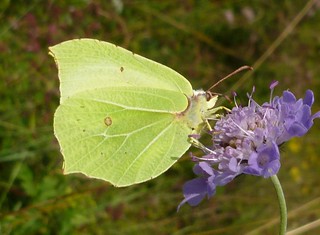 | Brimstone February to June and then July till October One of several butterflies that hibernates as an adult over the winter, the brimstone is often the first one you see in early spring. Large and strikingly yellow in flight - the original "butter fly" - they always fold their wings when they land so the only photographs you see are of their green underwings, which perfectly resemble a leaf (photo). Brimstones are powerful fliers and always seem to be in a hurry, rarely coming to rest. Females are much paler and can easily be mistaken for a large white, and for this reason are more rarely identified. There is a new generation in the summer, which is the one that hibernates to emerge in the spring: individual brimstones can therefore live for up to ten months. |
 | Small Tortoiseshell February to May, June to July, sometimes August to September Another butterfly that hibernates as an adult and appears very early in spring on warm sunny days. It then goes on to produce a new generation in the early summer which hibernates till next spring, though in warmer summers there may be a further generation in late August and early September. Small tortoiseshells have a useful habit of resting on footpaths, so you often see them when they fly up at your approach. Look out for them also on hedgerows. In late spring and summer don't confuse them with the superficially similar painted lady. Their underwings are very dark, making them look almost black in flight, a characteristic they share with peacocks. Despite their bright upperwings they are also well-camouflaged in early spring, blending in well with dead leaves from the previous autumn. |
 | Peacock February to June, July to October One of the most widely-recognised butterflies in England, not least because of its readiness to show off its wonderfully colourful upperwings. It is relatively easy to identify in flight too, though like the small tortoiseshell its dark underwings can make it look black as it flits past you. Peacocks are often seen on hedgerows, but seem to roam quite widely and are easy enough to see in parks or gardens too. Like the other hibernating butterflies, they find a cosy hole in which to spend the winter, appearing once the weather warms in early spring, and producing another generation in the summer that hibernates the next winter. The peacocks that are going to hibernate have a habit of popping up late in September or even into October, long after you have concluded that butterflies have disappeared for the year. Occasionally they also emerge on a sunny day in winter, realise their mistake, and go back to bed. |
 | Comma February to May, late June to October Less common than the other hibernating butterflies in spring, the comma is seen reasonably frequently in summer when the new generation appears. Males are often patrolling a particular territory, so if you disturb one from a bramble leaf, stand still and it will often return to exactly the same perch. Shady hedgerows and woodland rides seem to be the favourite habitat, and in such places in June or July you might mistake it for one of the similarly-patterned fritillaries. But the jagged edge to its wings is unmistakable. The reason for this unusual design becomes apparent when you see a comma with its wings closed, when its brown underside makes it look exactly like a dead leaf (photo). Having said that, in sunny summers the underside can be more orangey: when this happens the butterfly goes on to have another generation, which appears in August or September, popping up after you are sure all butterflies have disappeared for the year. |
 | Speckled Wood Late March to October If you see a brown butterfly flitting around inside a wood it is almost certain to be a speckled wood. They are a common species and found throughout the south east. An obliging habit of resting on sunlit leaves makes them relatively easy to identify and photograph. Its underwing is more rarely seen (photo). Unusually, speckled woods can overwinter as both caterpillars or pupae. (Apart from the hibernating adult species mentioned above, most other butterflies spend the colder months as caterpillars). This means that their appearance in is staggered and they don't have a pronounced gap between generations like other butterflies. |
 | Orange Tip Late March to mid May The lovely orange tip is above all an April butterfly, though it can sometimes be seen right at the end of March and usually lasts some way into May. Its appearance coincides with cuckoo flower (aka lady's smock) and garlic mustard, the flowers on which it lays its eggs (though it can sometimes use other crucifers). As these are common flowers along country lanes in the south east, the butterfly is regularly seen in such places during April - or rather the males are. The females look just like a small white (photo) unless you see them land and close their wings, in which case you will notice a distinctive mottled green pattern on their lower underwings (photo: the male also has this). All too soon cuckoo flowers and garlic mustard are gone and so are the orange tips for another year. Their young survive as pupae until the following spring. |
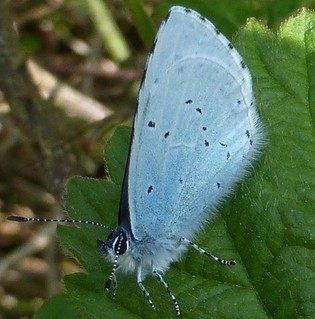 | Holly Blue Late March to early June, July to September The tiny holly blue is an elusive butterfly that you are most likely to notice as it flits along a bramble or garden hedge in April and early May, when it is the only blue butterfly on the wing. The spring generation does indeed lay its eggs on holly, but the summer one switches to ivy, making that a good place to look for them at that time. Male holly blues rarely seem to stop to rest, but if they do and display their upperwings, you see they are a deep blue that is very hard to tell from other blue species (photo). Females are more distinctive with darker borders to their upperwings (photo). What identifies both sexes conclusively are their light blue underwings, which are found on no other blue species. It is easiest to see these on females, who can sit motionless on a leaf with their wings closed for substantial periods of time, waiting the attention of males. In flight the pale underwings have the effect of making holly blues look almost silvery, so that you may think you are seeing a tiny white butterfly. The chalk hill blue also looks pale in flight but is only found on downland. In addition holly blues tend to fly about a metre and a half off the ground, which other blue species never do, so if you see one at this height near a hedgerow or garden, your identification is fairly sure. |
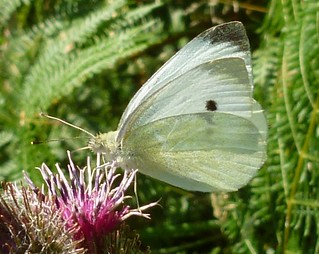 | Small White Late March to June, July to September In common parlance, white butterflies are just "cabbage whites", and they are easily the most widespread species in the south east, found everywhere from hedgerows to gardens to fields. They are about the only butterfly you regularly see flitting over arable crops. But in fact there is no such thing as a cabbage white, but rather three different species. Telling them apart is frustratingly difficult, because they are the most restless of creatures, rarely stopping to rest and then only for a moment. If you can catch one at sitting still, the small white has a smaller dark tip to its wings than the large white and lacks the green-veined underwing of the green-veined white. There are two generations each year, with a marked dip in numbers during June. In April what you think is a small white could also be the female of the orange tip, but that has a very distinctive mottled green lower underwing. |
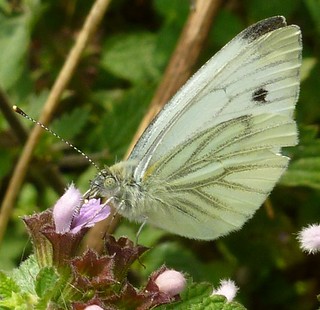 | Green-Veined White Late March to June, July to September It is the green veins on its underwing that identify this "cabbage white", but catching the critter at rest so you can get a clear view of this is not easy. If you get a close look at the upperwing, then the wing tip markings are slightly different from the large and small whites, having a sort of serrated edge to them as they go down the outer wing edge. It generally seems to be seen in and around hedgerows, though can apparently also occur in meadows and damper spots. |
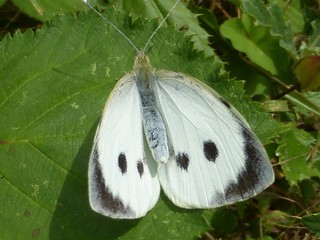 | Large White April to June, July to September This third "cabbage white" species is larger than the other two, though this difference is not always easy to see in flight. It has a much more extensive dark tip to the upperwing, descending down the outer edge. This is a very common butterfly, found almost anywhere, and this is also the species whose caterpillars prove a pest on garden flowers and cabbages. It is no less inclined to rest and be identified than either of the other two cabbage white species, and it is no coincidence that this photo is of a slightly more passive female. Though native to this country, large whites apparently also migrate up from the continent in May and can be seen flying in over southern coasts when the wind is favourable. |
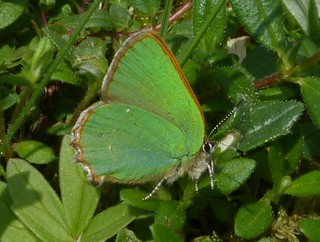 | Green Hairstreak Late April to May This is a very elusive butterfly, which you are only likely to see if you go to a site where it is known to be present - for example Aldbury Nowers on the Ridgeway near Tring station and the lower slopes of nearby Pitstone Hill; also on the lower slopes of Ranmore Common, at Hutchinson's and Chapel Banks near Croydon, Fackenden Down near Otford, and Wye Nature Reserve. It does not help that green hairstreaks are very tiny (the one pictured here is little more than 1cm high) and have green underwings which blend in perfectly with the rough downland, scrubby hillsides and heath that is their habitat. They are often best seen when they land on a shrub. Their upperwings are brown but these are never seen when they are at rest. Males spend a lot of time sitting guarding their territory, flying up when they see a rival. |
 | Dingy Skipper Late April to June The trouble with this tiny butterfly is that it looks exactly like a moth. Indeed it is often confused with day-flying moth species such as the burnet companion, mother shipton and common heath. Despite this it is reasonably widespread in the south east, particularly on rough south-facing downland (try the southern slopes of Box Hill or Ranmore Common near Dorking). Its food plant (as in this photo) is birdsfoot trefoil and that is also where it usually lays its eggs. |
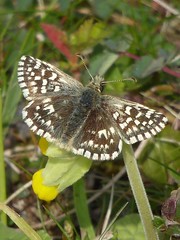 | Grizzled Skipper Late April to June This tiny butterfly is very hard to spot, even if you are in a place it is known to be present - for example Aldbury Nowers or the lower slopes of Pitstone Hill near Tring. In flight it looks much like one of those tiny micro moths that flit about the grass in summer - until you look closely and see the pattern on its wings. It roosts with its wings folded on a grass seedhead or flower head (photo) |
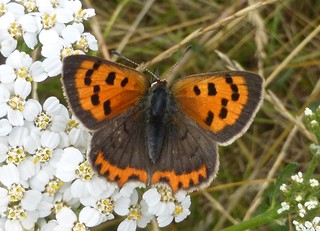 | Small Copper Late April to June, July to August, September to October This is another tiny butterfly - no bigger than a finger tip with its wings open - but its bright colours make it unmistakable when you see it. It is not particularly common but it is widespread - that is, it is found in all sorts of habitats including flowery hillsides, heaths, woodland rides and thistle-covered wasteground - and has a habit of popping up when you least expect it. In flight you might mistake it for the small heath (see below), but the latter never rests with its wings open and in any case has a quite different underwing. |
 | Duke of Burgundy Late April to mid June This is an elusive butterfly, which occurs on north or west-facing slopes on scrubby chalk or limestone downland with good numbers of cowslips. Examples include the northern and western slopes of Ivinghoe Beacon and Incombe Hole near Tring, and Kithurst Hill on the South Downs above Storrington. A small population also seems to exist at Chapel Bank, near New Addington, south of Croydon. Eggs are laid on cowslips, but otherwise neither sex visits flowers very often. |
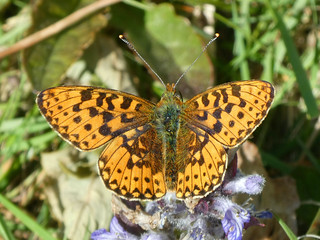 | Pearl-bordered fritillary Late April to early June Once a common woodland butterfly in spring, the pearl-bordered fritillary suffered catastrophic decline when coppicing fell out of favour in the 1970s and 1980s. Even though coppicing has now been revived as a way of managing woodlands, it is now only found in the south east at only a few sites in Sussex and seems reluctant to colonise new ones. But two of the sites - Abbot's Wood near Polegate and Rewell Wood north of Barnham - are quite accessible from railway stations, while Verdley Wood south of Haslemere can be reached on the Haslemere-Midhurst bus. They are also found in the Pignal and New Copse Inclosures in the New Forest near Brockenhurst. Pearl-bordereds fly with a gentle, swooping flight along open woodland rides and often feed on bugle. Like all fritillaries, they have beautiful underwings (photo). If you see a similar looking butterfly in other parts of the south east, it is likely to be a wall (see below: eye spots on the wings) or from June onwards a dark-green or silver-washed fritillary (see below). |
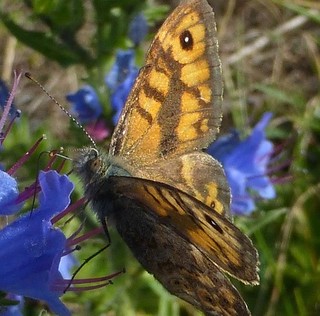 | Wall May to June, July to September Wall butterflies are no longer common, but can sometimes be seen along the south coast. They have a fondness for sunny places and for basking on paths (and in theory on walls, hence their name, though I have never seen this). Try the cliff tops between Dover and Kingsdown (especially the section from St Margaret's Bay to Kingsdown), Mill Hill Reserve and Lancing Ring near Shoreham-by-Sea, the downs above Upper Beeding, Cliffe Pools in North Kent, or the grazed area in Folkestone Warren. Further afield you can see them on the south west coast of the Isle of Wight, the Isle of Portland, and the ridge between Swyre Head and Kimmeridge Bay near Swanage. Walls can be confused in flight with a meadow brown, but they fly much faster and more purposefully, and once they stop the difference is clear. Though their wing markings are similar to those of the fritillaries, the eye on the wing tip is a giveaway (no fritillary has this). The male (pictured) has a large darker stripe across the centre of its wings (technically known as a "sex brand"), which the female lacks. Walls are very nervous butterflies, which fly up into the sky at the least disturbance, and so are a challenge to photograph. |
 | Small Heath May to October with a dip in numbers in July The key to identifying the small heath is its size - the one in the photo is about 1cm tall. Once you realise they are this tiny you no longer confuse them with meadow browns or gatekeepers, with whom they share a very similar (though not quite identical) underwing pattern. Small heaths are also found exclusively in grassland - not just downland but also ordinary meadows - and fly very close to the ground, typically no more than a metre off it. Their upperwings are orange and when you see one flit by you may think it is a large, small or essex skipper. But unlike those butterflies, when it lands a small heath always shuts its wings. |
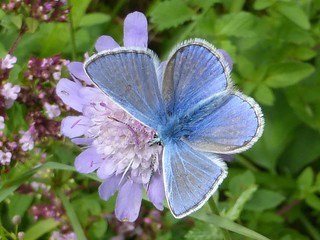 | Common Blue May to June, July to September Common blues are well named because any butterfly of this colour that you see is highly likely to be one. In fields or grassland away from chalk downland you can almost guarantee that is what you are seeing, though near hedgerows a butterfly flying about a metre and a half off the ground is likely to be a holly blue (see above). What will surprise you about common blues is how very small they are. But despite this they are easy to spot because of the intense blue of their upperwings. They are most commonly found in grassland - flower-rich downland is a very good place to see them - but can also be seen along countryside verges and in all sorts of unexpected places. Their underwings are a light brown with black spots (photo), which clearly distinguishes them from holly blues, which have light blue underwings. On chalk downland they could be confused with the chalk hill blue (see below) but these are much lighter on top and somewhat larger. On south-facing downland at the adonis blue (see below) is also a possibility, but these are fairly rare. Common blue females are quite different, with brown upperwings with just a blush of blue around the body (photo). They look almost identical to the brown argus (see below): detailed examination of the spots on the underwing is necessary to tell these two apart, though the brown argus tends to be smaller. Also similar is the female chalk hill blue, but it is a bit larger and has less obvious orange markings. A few females also have much bluer colourings (photo). |
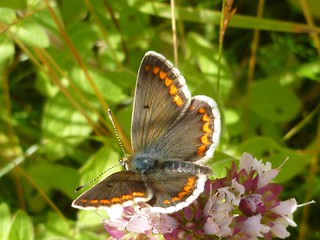 | Brown Argus May to June, July to September Brown argus numbers are increasing and they can now apparently be found not just on chalk downland, which is the most obvious place to see one, but on roadside verges and in overgrown fields. The big problem, however, is being sure you are looking at a brown argus. It looks extraordinarily similar to the female of the common blue (photo), but is in general a neater butterfly, with the orange chevrons extending right around the edge of all four wings in the female, and nearly all the way in the male (pictured). In common blue females, by contrast, the orange chevrons fade away noticeably towards the top of the forewing, and there is a white border below the black dots underneath the chevrons on the hindwing. The male brown argus is also smaller than the common blue, but the female is almost exactly the same size. The underwing is not much help - it looks very similar to that of the common blue, though with a slightly different arrangement of dark spots. Probably your best bet is to take a photo and try and get the good people at iSpot to identify it for you. |
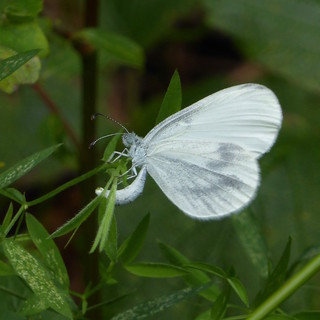 | Wood White May to June, July to August Wood whites do not look like any of the other white species. They are smaller, have a rather feeble flight and are found exclusively on woodland rides. They have sadly died out in most parts of the country and now survive only in a few pockets. One is the Butterfly Conservation reserve at Oaken Wood, near Chiddingfold, north of Haslemere, where this photo of a female laying eggs on bitter vetchling was taken. |
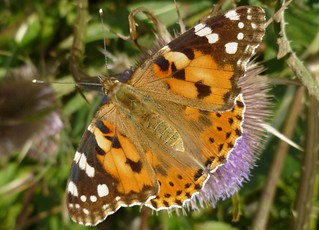 | Painted Lady May to June, July to September To see a painted lady is always exciting. This glamorous migrant breeds over the winter in North Africa and southern Europe and then spreads northwards in successive generations. How many get to the UK depends on what kind of success they have had further south. In some years - the last being 2009 - there can be very large influxes. A few are usually seen in May or June, but they are more numerous in the summer months when the offspring of the first arrivals are topped up by further migrants. They like sunbathing and feed on thistle and mallow plants, and so often add a touch of beauty to scrappy bits of wasteground. It used to be thought that painted ladies were then simply killed off by the autumn cold but in the last few years new technology has proved that they head off back south again. They do this by flying up into the sky to catch high level winds, which is why this reverse migration had never previously been detected. |
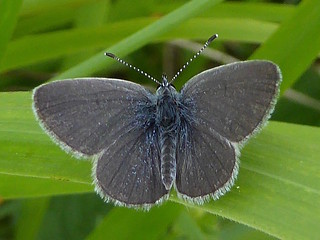 | Small Blue Mid May to June An extremely tiny and hard to spot butterfly - the smallest of all the British butterflies. Confusingly, it is brown not blue, though has a bluish tinge at the base of its grey-brown underwing (photo). It is found mainly on downland, feeding on birdsfoot trefoil and horseshoe vetch in small localised colonies, for example on Pewley Down near Guildford, at Hutchinson's Bank just south of Croydon, on Fackenden Down near Otford, or at Yeosden Reserve near Saunderton in the Chilterns. |
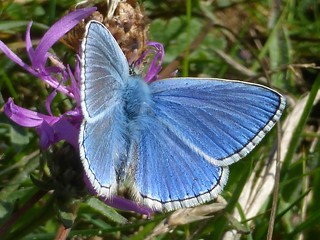 | Adonis Blue Mid May to June, August to September This is a very elusive butterfly. It is only found in the far south of England on south-facing downland slopes with short, flower-rich turf - particularly the South Downs (try the Mill Hill Reserve north of Shoreham-by-Sea) and the slopes below Ranmore Common near Dorking. Populations are greater in the summer generation than in the spring one. As well as being scarce, the adonis is very hard to distinguish from the common blue. If you see the two together you will see that the adonis is a lighter blue - often described as sky blue - but the common blue can also look fairly light in flight. So most times when you think you are seeing an adonis blue it is in fact a common blue. What marks out the adonis is that it has faint black lines going right across the white border of its upperwing: the common blue sometimes seems to have such lines, but they are only stubs, dark marks along the inner edge of the border. Just to make matters extra confusing, as the adonis ages the black lines can fade, making the upperwings of the two species indistinguishable. Their underwings are definitely different, however. That of the adonis is more brown (photo) than that of the common blue - it looks much more like the underwing of the common blue female, in fact. If you see the combination of blue upperwing and brown underwing then you can be pretty sure of your identification. The underwings of the two species also have subtle differences in the arrangement of the spots and the orange chevrons on the wing edge, but you can go boss-eyed trying to cross check these. The adonis does, however, have black lines through the white border on the underwing, something common blues lack, though again these can fade with age. It also lacks the bluish blush near the body of the male common blue underwing, having an yellow-green tinge instead The female adonis is even more elusive than the male and very brown - the wing border markings on her upperwing being so faint as to be almost invisible. Dark lines through her white wing border are once again a sure identifying sign. |
 | Glanville Fritillary Mid May to June This butterfly is found only on the undercliffs, cliff tops, chines and chalk downs in the southern half of the Isle of Wight, though some were introduced into Hutchinson's Bank near New Addington south of Croydon in 2011, where they were still surviving in 2023, having also spread to nearby Chapel Bank. Though quite hard to catch a glimpse of, their underwings are particularly beautiful (photo). If you see a similar looking butterfly in other parts of the south east, it is likely to be a wall (see above: eye spots on the wings) or from June onwards a dark-green or silver-washed fritillary (see below). |
 | Marsh Fritillary Mid May to June The marsh fritillary is a butterfly of the West Country rather than the south east, though some do stray into the western part of our region, for example into Bentley Wood near Salisbury or Hartslock Hill near Goring-on-Thames. In recent years some have also been seen at Incombe Hole near Tring and at Yeosden Reserve near Saunderton, both in the Chilterns. A small population may also exist at Hutchinson's Bank near Croydon. A more reliable place to see them is Strawberry Banks, near Stroud in Gloucestershire. Despite the name, they can be found on drier downland slopes where devilsbit scabious is found, though damp grasslands are their more normal home. Like all fritillaries they have a striking underwing (photo), but tend to rest with their equally lovely upperwings open. |
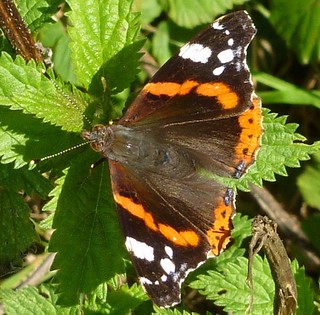 | Red Admiral Late May to October, sometimes also in winter Most people can recognise a red admiral, and so might be surprised to learn that it is not a resident species but a migrant that flies up from North Africa or Southern Europe. They are a very widespread butterfly, seen in hedgerows, gardens and many other habitats. The first influx is of females in late May or June: having mated before they arrive, these quickly lay eggs on nettles. Their offspring then emerge from July onwards, topped up by further migrants. At this time of year they can be territorial, so that if you disturb them they sometimes fly around and come right back to the leaf they were sitting on. By mid August the migration starts to reverse, but some stay in the UK and can pop up unexpectedly as late as early October. A few also seem to overwinter in the south east, and just occasionally on a sunny day in January or February you can see the incongruous sight of one flitting about along a field edge. There is no evidence that these winter survivors go on to breed, however. |
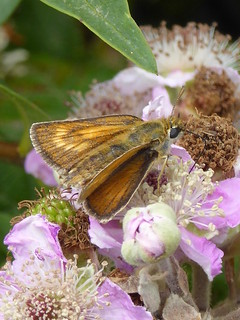 | Lulworth Skipper Late May to early September If you are on holiday in Lulworth, then a walk on the downs above the village might well introduce you to this tiny little butterfly. Found only in this one place, it is nevertheless quite common and easy to spot One of a family of butterflies that looks more like moths (see dingy skipper above, or the large, small and essex skippers below), the Lulworth skipper could be easily confused with a large skipper, but is smaller and has different upperwing markings. Generally, though, the location will be the main key to identification. |
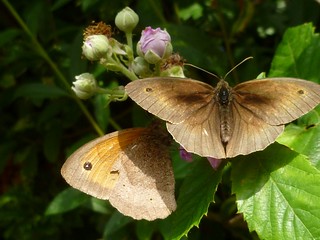 | Meadow Brown June to September Meadow browns are extremely common - almost boringly so. Setting out to look for butterflies in summer you find yourself thinking "Oh, just another meadow brown". Their habitat is grassland - they lay their eggs there - as well as nearby hedgerows and wood edges. In flight their upperwings look brown, but if you see one at rest the male sometimes has a hint of orange around the eye in the corner, while the female has quite a bit more. Both often rest with their wings closed, but not always. They are one of the few butterflies that fly on overcast days. Meadow browns are frustratingly similar in appearance to gatekeepers and to ringlets - see below for both of these. But all too often when you think are seeing one of those, what you are actually seeing is an ordinary old meadow brown. |
 | Large Skipper June to July The large skipper is not large - it is tiny, about a centimetre long. And it doesn't look like a butterfly at all. Instead, it flies like a moth, folds its wings like a moth, and looks less like a butterfly than several of the day-flying moths do. But a butterfly it is, according to the scientists It lays its eggs in rough grassland and so is found in such habitats, but also can be seen perching on nearby hedgerows. It comes to rest fairly often and that gives you a chance to examine the finer detail of its wings. If they have darker botches around the edge, as in this photo, then it is a large skipper you are looking at. If not, then you it is either a small or essex skipper (see below). |
 | Ringlet Mid June to July The ringlet can be found along hedgerows but also in grassland near wooded edges. They are less common than meadow browns but nevertheless still quite abundant in some years. Exactly how numerous they are is difficult to work out because in flight they look exactly like a meadow brown, only possibly a slightly darker, more chocolatey shade (at least when fresh). The only way to make a positive identification is to wait for the butterfly to come to rest, which neither species is inclined to do. If you get to see their underwings identification is easy, as the ringlet's is brown and dotted with concentric rings, while that of the meadow brown is orange in the upper half and a mix of brown and beige shades below. Telling the butterflies apart by their upperwings can be a lot more tricky, however. You should in theory be able to see concentric rings on the edge of the ringlet's upperwing (photo), while a meadow brown has an eye in its upperwing corner and a hint of orange around it. But in both species these markings fade quickly with age and eventually their upperwings are practically indistinguishable. |
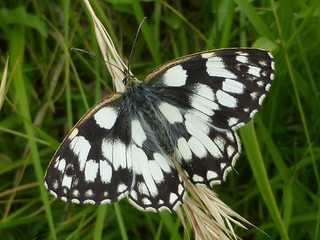 | Marbled White Mid June to mid August The lovely marbled white is one of the most beautiful of all our summer butterflies, especially when it shows its delicately patterned underwing (photo), which is browner in females than in males. Very much a grassland butterfly - though seen at times in other places - large numbers of them can congregate on flowery downland in late June and early July to mate, the long slope of Box Hill above Burford Bridge being a good place to see them. The females take up position on a favourite flower - often knapweed, though scabious and other purple or pink flowers will do. The males come up and there is much fluttering of wings which decides whether mating takes place (photo). In favoured spots one can disturb clouds of eager suitors at every step: on Box Hill I have counted as many as 150 in a single hour. Marbled whites (which incidentally are a member of the brown butterfly family, cousins to the speckled wood and meadow brown) are also gratifyingly easy to identify even when they are on the wing - the white and black patterning is unmistakable. Though easily disturbed they also never seem to fly far before settling again and so are relatively easy to photograph. |
 | Silver-Studded Blue Mid June to early July is the best time The silver-studded blue could easily be mistaken for a common blue, though it is a bit smaller and the male has dark borders to its upperwings. (The female's upperwings are brown, as is the case with several other blue species). Identification comes from the distinctive markings on its underwings, and from the fact that it likes sunny heathland sites. Very rare nationally, it just happens to find these conditions on the Surrey heathlands and quite large colonies can be found near Worplesdon, on Fairmile Common near Oxshott, and on Hindhead Common near Haslemere. Look for them perched on heather or gorse. |
 | Small Skipper Mid June to July The small skipper is only a bit smaller than the large skipper (see above), and it is found in similar habitats, liking to feed on knapweed and thistles, and needing rough grass that is not cut in winter on which to lay its eggs. Like the large skipper it is moth-like in appearance and flight. It can be distinguished from the large skipper by the pure orange of its wings, with a thin dark border but without the darker blotches around the wing edge that the large skipper has. Males have a small darker bar across the upper wings - a "sex brand". Unfortunately it also looks identical to the essex skipper (see below). The only way to reliably tell the two apart is that the small skipper has a brown underside to its antennae, while the essex skipper has a black underside. It seems incredible that any casual observer could spot such a tiny difference on a creature that is already very small, but it is possible to see if you get up close. Both both species are reasonably cooperative about letting you do this. |
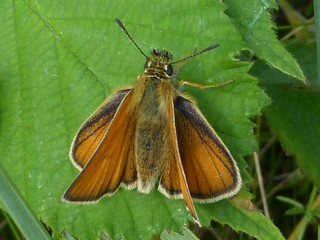 | Essex Skipper Mid June to July Identical to the small skipper above, apart from the black underside to its antenna, the essex skipper lives in similar habitats and behaves in a similar way. It supposedly appears slightly later than the small skipper, though since there is always a bit of variability in timings year to year, this is probably not much help to a casual observer. |
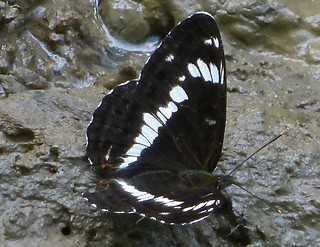 | White Admiral Mid June to July This is another elusive woodland butterfly, and one which always seems to be in a hurry, flying rapidly and purposefully through a woodland clearing. They can be tempted by a bramble flower or (as here) by a moist patch of mud, but never stop still for long. Bookham, Epsom and Ashtead Commons near Leatherhead are good places to see them. |
 | Heath Fritillary June The heath fritillary is found only in a few tiny strongholds in England, one of which happens to be Blean Woods between Herne Bay and Canterbury. It is a butterfly of coppiced woodland that takes to the wing on fine sunny days. East Blean Woods Nature Reserve is one good place to see them and in favoured spots they can appear in quite large numbers. There is also a population in Hockley Woods in Essex, a stop on the railway line to Southend Victoria. Their upper wings have a chequered pattern (photo) similar to that of the Glanville fritillary and Duke of Burgundy. |
 | Black hairstreak Mid to late June Black hairstreaks are mainly confined to a few sites in the Midlands, but can be seen in the south east at the northern tip of Ditchling Common to the east of Burgess Hill, and in the scrublands at the heart of Epsom Common. They spend most of its time feeding in the top of small trees, but in the early afternoon they sometimes come down and hunt for mates around mature blackthorn bushes. Like white-letter and green hairstreaks, they only ever come to rest with their wings closed. |
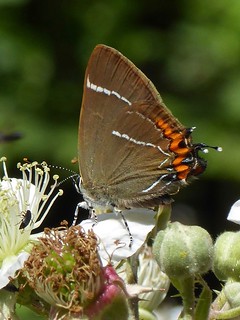 | White-Letter Hairstreak Mid June to mid August You would have to be very lucky to catch sight of a white-letter hairstreak by chance, though they can be seen feeding on bramble, thistle or hemp agrimony flowers. Their upperwings are brown so they might easily be confused in flight with a meadow brown or ringlet: unlike those two butterflies they always rest with their wings closed. Their caterpillars feed on elms and so they suffered badly when Dutch Elm Disease struck in the 1970s. However they can survive on hedgerow elms as well as on wych elm and so are more widespread in the countryside than you might expect. |
 | Silver-Washed Fritillary Late June to August The silver-washed fritillary is a magnificent sight as it glides through woodland clearings. One of our largest butterflies, it has a stately, dignified flight as it swoops over bramble bushes looking for a mate. They are fairly widespread in the south east and can crop up in quite ordinary woods, but if you want to be sure of seeing them go a nature reserve where they are known to fly, for example Bookham Common or Ashtead Commons near Leatherhead, or Homefield Wood near Marlow. The males can be distinguished from other fritillaries by the streaky lines (known as sex brands) on their upperwings, though usually the habitat will provide you with the identification as the silver-washed is the only woodland fritillary to be found at this time of year. Having said that, it is just possible that a dark-green fritillary may be found on woodland rides, though this is very unusual. Slightly more often silver-washed fritillaries stray into fields or downland near woods, normal dark-green territory. The one other butterfly you might confuse it with is the comma (see above), which is also orange with darker markings and also flies in woodland. But the comma is usually defending a territory and returns to a specific perch, while silver-washed glides by in long sweeps, as if surveying the whole wood, only stopping to feed. The female, which tends to skulk in the shadows, sometimes resting on the trunks of oak trees, lacks the streaks and has a more browny colour, sometimes looking almost like a different species (photo). Both sexes have a green tinge to their lower underwings which is streaked with silver stripes, hence the butterfly's name. |
 | Purple Hairstreak Late June to August Even though they are quite common in oak woodland, you have to have sharp eyes to see a purple hairstreaks, since they spend all their time in the treetops. But they do occasionally come down to lower levels. Unlike other hairstreaks, they sometimes rest with their wings open, showing the wonderful purple markings of their upperwings, This one kept its wings firmly shut, however. |
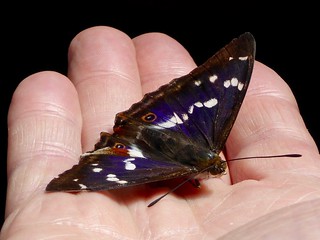 | Purple Emperor Late June to the end of August The largest of the UK butterflies, the purple emperor is another butterfly that spends its time almost entirely in the tops of oak trees, only coming down to the ground to feed on minerals (for example dog poo) or to lay its eggs on goat willow trees. It is thus unlikely that you will spot one in the course of an ordinary walk, but it could just happen. Epsom Common has a good population and the Knepp Wildlands south of Horsham are supposed to have one of the highest concentrations in the country, along with convenient tree platforms that should improve your chances of seeing these elusive butterflies. The iridescent purple hues to the male's upperwings are only visible at certain angles and they are lacking altogether in the females. The rarely seen underwings are brightly coloured (this photo is from an example that was sadly found dead). |
 | Dark-Green Fritillary Late June to July The dark-green fritillary is the easiest fritillary to spot in south east England, because it is very fond of flower-rich chalk downland, where its bright orange upperwings make it relatively easy to see. Try the Hutchinson's Bank or Chapel Bank near Croydon, the landward edge of the hill on which Belle Tout lighthouse stands near Birling Gap, or Castle Hill Reserve near Lewes. In theory it can also turn up on woodland rides, but I have never observed this. Dark-greens are yet another butterfly that loves knapweed. Males feed on this flower (though otherwise can fly quite fast and straight, looking for mates) and females perch on them waiting for a mate. Differences between the two sexes are trivial - a slightly lighter border in the female. On their lower underwing both sexes have silvery spots on a green background (photo): not really dark green, but that is where their name comes from. |
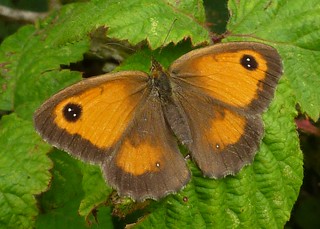 | Gatekeeper July to mid August The gatekeeper is another butterfly you might initially mistake for a meadow brown, but it is smaller, has a different pattern on its lower underwing (photo) and when it lands on a bush and opens its upperwings has a much larger area of orange. (The one pictured is a female: the male has a pair of darker stripes across the upper orange area - a "sex brand") Its habitat is the hedgerow and it loves to feed on bramble flowers, but always seems to emerge just as the bramble flowers are going over. You can also find it feeding on flowery patches or shrubs on chalk downland. Unlike the meadow brown and the ringlet, it is quite a cooperative butterfly, being happy to sit with its wings open and be photographed. If you see one, there are nearly always others nearby. |
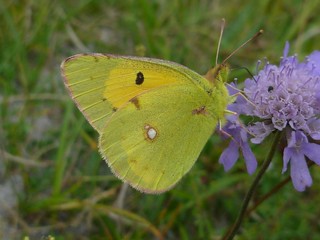 | Clouded Yellow Possible May-June, but most likely July to September Seeing a clouded yellow is an event. This is another of those migrants from southern Europe which can occasionally turn up in large numbers, but is otherwise just an occasional sighting. It apparently all depends on whether we get any arrivals in spring. If we do, then they lay eggs on clovers or birdsfoot trefoils and there is a much bigger brood later in the summer, which is when you are most likely to see them. Whatever, they are a magnificent sight as they fly past, with their upperwings orangey-yellow with striking black borders. When they land they show a more demure green and yellow underwing, which you might just mistake for a brimstone if you are not looking carefully. Clouded yellows always seem to be in a big hurry. They fly past, you think "Oh, was that a…?" and then they are gone. |
 | Grayling Early July to mid September This extremely elusive butterfly can in theory turn up in various habitats, but in the south east the main place to see it is on the Surrey heaths (try Purbright Common near Brookwood). Even in a known site they are hard to spot, having a very nondescript appearance which could easily be mistaken at a casual glance for a faded meadow brown. Your best chance of seeing one is if you disturb one while walking. But even if you see where it lands, its camouflage is so good that it can be invisible even when only a few metres away (see photo). Compounding this is a tendency to sit end on-to the sun on hot days, putting its wings in shade (and making it annoyingly hard to photograph). On cooler days or in the early morning graylings may sit side-on to the sun, however, and raise their forewings, which are orange with two eye markings, to gain some heat. The upperwings are always closed when the butterfly is at rest |
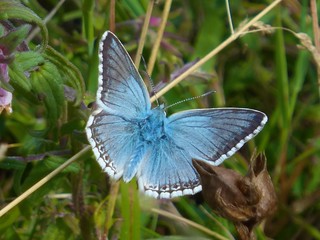 | Chalk Hill Blue Mid July to August Nearly half the 59 species of butterfly to be found in the UK are rare or very localised, but in the south east we are lucky enough to have one that is quite easy to see. A butterfly of flower-rich chalk downland - it is another lover of knapweed and scabious flowers - chalk hill blues can be seen in large numbers in favoured locations. Good sites are Castle Hill Reserve near Lewes, Pewley Down near Guildford, Tennyson Down on the Isle of Wight, and the southern slopes of Box Hill and Ranmore Common. You know straightaway that you are looking at a chalk hill and not a common blue because in flight they look much paler - sometimes almost white. When the males land you see that they are in fact quite richly coloured. The dark veins across their upperwings and the dark areas on their wing tips confirm the identification. They are also a bit bigger than the common blue, but still tiny for all that. The male's underwing (photo) is like that of the common blue, though paler in the forewing and with subtle differences in the layout of the spots. The female, which lurks in the grass or on a favoured flower waiting for a mate, is chocolate brown both in its upperwing (photo) and underwing (photo). This makes it very similar to the brown argus or female common blue, but the chalk hill is larger with much less prominent orange markings. |
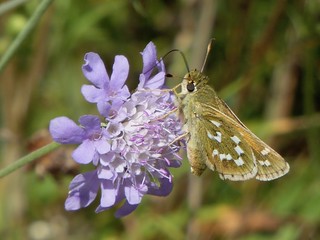 | Silver-Spotted Skipper Late July to mid September This late summer butterfly is to be found only on sunny chalk downland slopes with short turf, and no further north than the Chilterns. Brockham Quarry near Dorking is one good site, as is the southern slope and zigzag valley of Box Hill. Even in these habitats it is hard to spot. It is tiny, like all the skippers, and the male flies from place to place with incredible speed, sometimes seeming to jump like a grasshopper. It feeds on flowers such as marjoram, dwarf thistles and (as here) field scabious. If you do see one you might easily conclude you are looking at a large skipper, but the silver-spotted has yellow squares on its upper wing edges and white ones on its underwing. Its flight period also only overlaps slightly with the large skipper, which tends to be found in longer grass. |
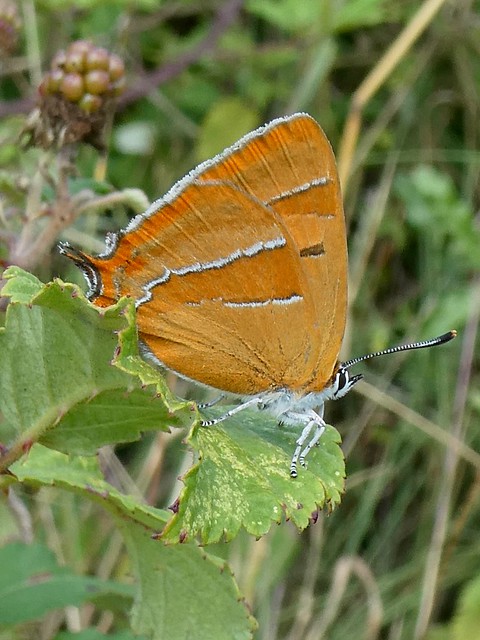 | Brown Hairstreak Late July to late September This is another butterfly that lives almost entirely in the treetops. Only the female comes down to ground level, to lay her eggs on blackthorn bushes (where she is well camouflaged among isolated tinted leaves) and sometimes to feed on bramble, thistles and hemp agrimony. To see this butterfly you need to be in a place where they are known to be present - Bookham Common is one place, and Hutchinson's Bank - and be both patient and lucky. Late morning or early afternoon on a warm sunny day is the best time. |
© Peter Conway 2016-23 • All Rights Reserved
No comments:
Post a Comment